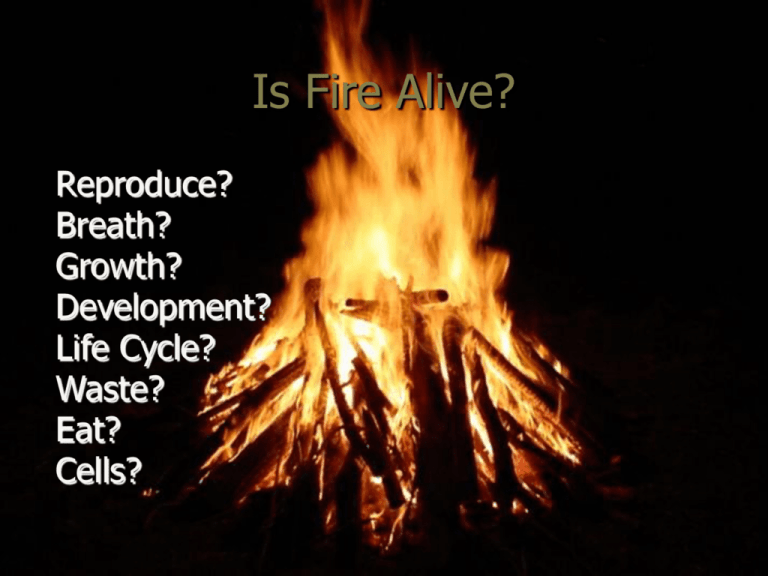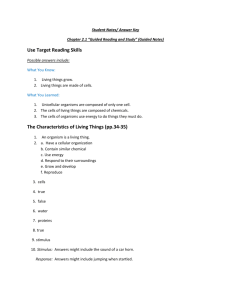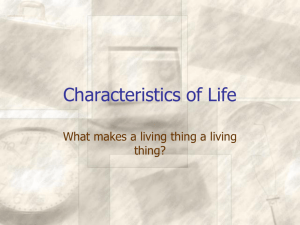Introduction to Biology
advertisement

Is Fire Alive? Reproduce? Breath? Growth? Development? Life Cycle? Waste? Eat? Cells? Introduction to Biology What is Biology? “Bios” means life “logy” means the study of What do we get when we put the two words together? “Biology” = the study of life The science that seeks to understand the living world A biologist uses scientific methods to study living things What is life? Life extends much further than what you can see. Everywhere around you, all over your desk, the walls, the floor, the ceiling, your clothes, and even your skin, you can find billions and billions of tiny microscopic life forms. What kinds of things are alive? Living things are called organisms. There are many different types of organisms Animals (humans, insects, birds, mammals, fish, reptiles, amphibians) Plants (trees, grasses, bushes, shrubs) Fungi (mushrooms, mold, yeast) Bacteria Protists (algae) What are some things that living things have in common? Made up of units called cells Reproduction Based on a genetic code Growth and development Obtain and use materials and energy Response to the environment Maintaining stable internal balance Evolution Living things are made of cells Cells are the basic building units of all forms of life. a collection of living matter enclosed by a barrier that separates the cell from its surroundings Example: a sandcastle looks “smooth” but on closer examination, it is made up of millions of tiny grains of sand. An elephant also looks “smooth,” but if you could get close enough and if your eyes were powerful enough, you would realize that the elephant is really made up of many billions of cells. Cells make up every part of a living thing. For example, skin, blood, bones, nerves, and muscles are all made up of cells. Living things reproduce Reproduction is the process of organisms producing new organisms similar to themselves There are two kinds Sexual reproduction- process by which cells from two different parents unite to produce the first cell of the new organism Example: union of female egg cell with male sperm cell Asexual reproduction- process by which a single parent produces a new organism by itself Example: splitting of bacteria cells Living things are based on a genetic code A molecule called DNA carries the genetic code which determines the inherited traits of every organism. Living things grow and develop To grow means to get larger in size. To develop means to change shape & structure throughout life. Examples: Frogs begins life as tadpoles and then change into an adult frogs. Butterflies start life as caterpillars before maturing into full grown butterflies. Living things need materials & energy Most of us call this eating! But then we have to be able to convert our food, a form of energy, to chemicals our cells can use through metabolism. Metabolism is the combination of chemical reactions through which an organism builds up or breaks down materials as it carries out its life processes. Photosynthesis is when plants convert the sun’s energy into stored chemical energy. Living things respond to the environment Organisms can detect stimuli from the environment. A stimuli is a signal to which an organism responds. Examples: Reflex of quickly removing your hand from a hot stove Leaves and stems of a plant grow toward light Living things maintain an internal balance Organisms must keep their internal conditions stable with a changing external environment. Homeostasis is the process by which organisms maintain a relatively stable internal environment. Example: Humans have an internal "thermostat" that helps us maintain a body temperature of about 98.6 degrees F. To keep body temperature up when the weather gets cold, your body shivers To keep body temperatures down when the weather gets hot, you sweat As a group, living things change over time Evolution is a change in a kind of organism over time. So again…What is life? Defining "life" is a very difficult task, and scientists don’t all agree on a common list of the characteristics of life. Many of the characteristics of life are not limited to living things. For example, is fire a living thing? It uses energy, grows, and can reproduce… But it is not considered to be living because it is not made of cells, lacks a genetic code, & cannot evolve In order to be considered a living thing, something must have all of the characteristics. Biology in Everyday Life Helps you understand and appreciate other organisms Provides information about food and methods for sustaining world’s food supplies Describes conditions of good health & behaviors & diseases that can harm you Diagnose and treat medical problems Identifies environmental factors that can threaten you







